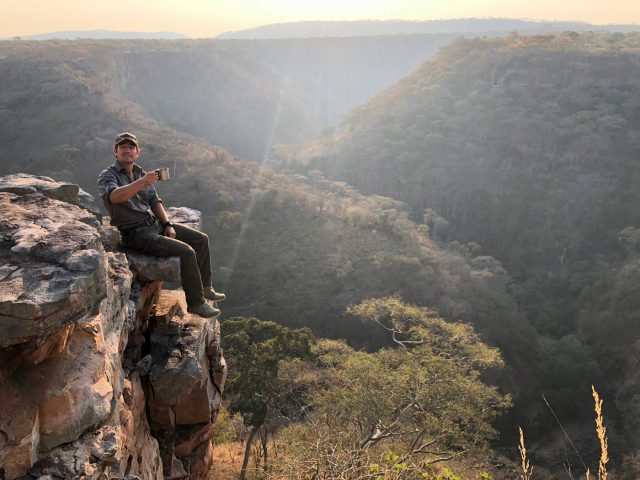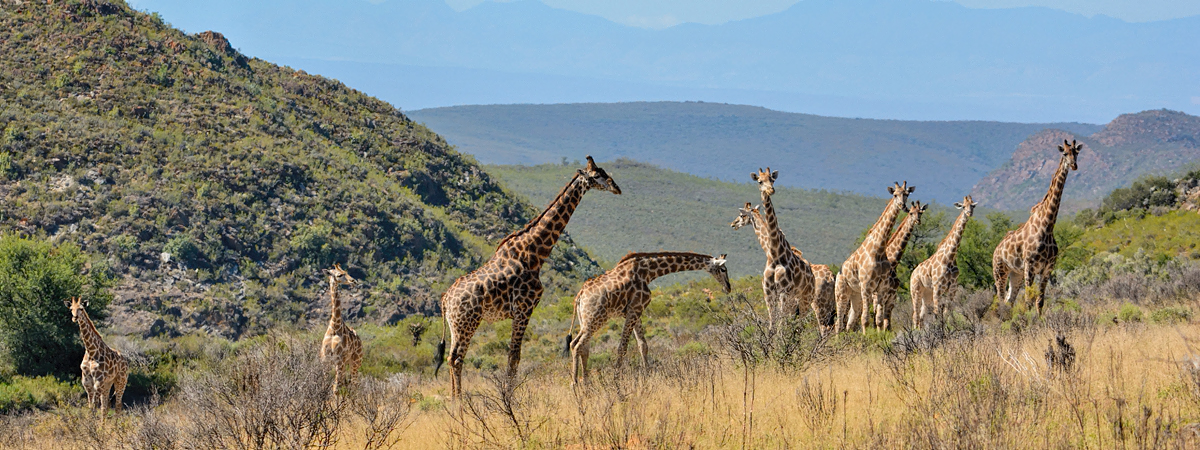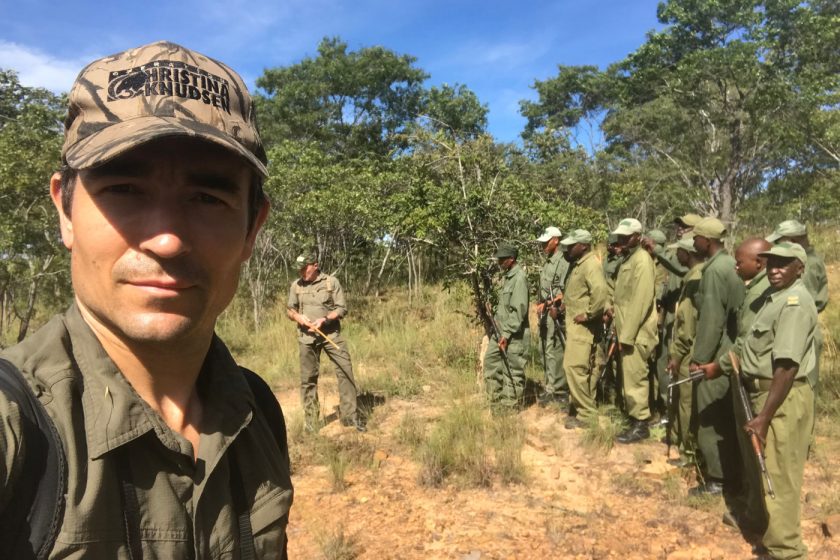The third instalment of our interview with Dr Niall McCann, Director of National Park Rescue.
Part 1 was posted here on 22 October 2019
Part 2 was posted here on 23 October 2019

TMD – How do you decide when you’re ready to move on? If we take Chizarira as an example, how long would you expect to to be there and when you’re finished is African Parks lined up to come in and take it on, or is someone else going to do it?
NM – Our MOU (Memorandum of Understanding) in Zimbabwe is for 5 years with an option to renew for a further 5 years, so that gives us 10 years, up until the end of 2027. At which point I would like to think that the Zimbabwean tourism model is back up and running again so that Chizarira can be operating in a sustainable way.
We’re creating a functioning micro economy between the Park and the communities that should function if we leave. The Park buys the food from the communities, the communities are benefiting from tourism, the largest employer in the area is the Park; at the moment it is us, but when we leave it should be the Park.
The Park needs to be generating enough money from tourism in order to do that.
In 2017, before we arrived, there were under 100 visitors. Under 100 visitors to Chizarira and that is absurd. Each one would have been spending about USD30 to be there so you’ve got about USD3000 of net receipts which is not enough to pay for a month’s worth of staff, so that needs to improve massively before that Park can be sustainable.
TMD – Is it realistic to expect Chizarira to be sustainable?
NM – No. But if you look at other countries in Africa there are ‘honeypot’ parks that fund the rest. Bwindi NP funds the entire National Parks system in Uganda because everyone goes to see the gorillas and that pays for Murchison Falls and everywhere else.
In Zimbabwe Hwange is always going to be the big money spinner, or Mana Pools, just because they are more accessible from the main hubs of Victoria Falls and Harare. Chizarira is never going to earn that kind of money but if it can be ticking over and be propped up by a major boost in tourism in the other Parks then fantastic.
Otherwise you’re reliant on external donor support or a complete shift in the mentality of the country whereby natural resources are seen as being an integral part of their economy not something to be exploited.
TMD – So you’re going to be in Chizarira a lot longer than you were in Liwonde.
NM – Absolutely. That was our intention from the start and that was why we signed up to this contract. Because we realised that those short term interventions are not sustainable unless you can guarantee that someone will come in after you.
Why don’t we be that person that comes in after? Why don’t we do the whole thing?
Do that short term intervention so it’s safe but then see that transition though until the Park is actually functioning again.
Chizarira was on its knees when we got there and now it’s in a much more impressive state but there’s a long way to go and my aim, within 10 years, I’d love to be able to bring rhinos back and that’s going to take a lot of organisation. It used to have between 200-300 black rhinos, it was the highest density in Southern Africa. All but 30 were killed between 1989 and 1994. The final 30 were caught and transferred to other Parks, like Matusadona, and then they were killed there. What that means is that we’ve got an ecosystem that can support a decent density of black rhinos and there’s a decent number of black rhinos down in Save Valley and the Lowveld.
If we can get the Park functioning, by functioning I mean if we can get the law enforcement capacity sufficiently high that I feel we’re safe to bring rhinos back and that we can protect those rhinos then that would be an extraordinary achievement.
I would love to do that, to re-populate Chizarira with rhinos but the rangers and our team must be ready, because if you do that there’s a target on your back.
TMD – Is it likely that Chizarira’s future is going to be as a National Park, in the same sense that Hwange is a National Park or is it likely that it will be given over as one massive concession to be managed by a private organisation?
NM – Hmm. Zimbabwe would have to change it’s mentality around the use of National Parks. They would either have to de-gazette it and change its land use purpose, so de-gazette it and turn it into a safari area. They could do that but I don’t think they will, I think they’ll keep it as a National Park.
What I’d like to see is that they go down the same lines as they have with Gonarezhou. So they allow a private organisation, be that us or someone else, to create a trust in joint partnership with the Parks Authority.
TMD – You’re talking about Frankfurt Zoological Society (FZS)
NM – Yes. They’ve got a trust with a rotating Chair. One year it’s FZS, the next year it’s the Parks and that’s a really functioning model and that Park is doing wonders. The fact that that precedent has been set means we know that the Parks Authority would be willing to look at that again and we’re the best placed organisation to do that, after FZS. So let’s see how we feel about that when this first MOU term finishes at the end of 2022.
TMD – Presumably that would entail you having access to a significant increase in funding.
NM – Yes, of course, and part of that is having a public launch, which we will do this year.
We’re really careful because of the sensitivity of what we’re doing, the sensitivity of the government and the sensitivity of our operations but we know that we need to have a decent online presence with regular updates about what we’re doing, a newsletter and everything else. That will happen this year and will hopefully boost our profile.
The way our profile is boosted at the moment by people realising ‘these guys that are there are doing a really good job’. People come and visit Chizarira or hear about what we are doing or I give talks and people realise what an impact we are making. Organically our reputation has grown and we’re getting to a position when we do launch publicly we feel we now have quite a strong model.
We didn’t want to launch too early when we didn’t have much to shout about whereas we’ve now got Liwonde, a successful pilot operation and Chizarira, 18 months in, no elephants killed on our watch.
TMD – How many elephants were there that you had to look after (protect)?
NM – 749 according to the last census (The Great Elephant Census 2014) but we reckon there were more like 400 – 500. The 2006 Census had about 3500 so it’s been an extraordinary drop.
Not all of those will have been poached directly, but that population will have dropped because of the pressures related to poaching. Some would have been directly poached, others would have moved on because elephants don’t hang around if they’re mates get shot, so they’d have moved on elsewhere and they would have probably been killed on the communal lands.
TMD – I was going to ask where you plan to go next, but you’ve still got 8 years hopefully in Chizarira. Would you already be identifying places to go next?
NM – Yes. My aim is for NPR is that within 5 years – so 3 years from now, 5 years of us being operational in Chizarira – is that we have 2 parks and within 10 years that we have 5. That might be an overly ambitious growth wish but that’s similar to what African Parks did. It is basically funding dependent.
We can identify the right people in order to be able to run parks in different countries, that’s not a problem, it is funding dependent.
TMD – In an ideal World, which of course doesn’t exist, if you’ve got a park and you can get the communities around that park to see that they can benefit from supporting the park and, in effect, helping protect the wildlife, then you’ve got a natural barrier against poaching.
NM – Chizarira is slightly different; we’ve got 8 communities that surround it that are more or less hostile to the Park.
One of the issues for those communities is that many of them were moved out of the Zambezi Basin when Lake Kariba was created so they are already anti-government because the government had told them to leave their ancestral lands and settle this new area, which wasn’t as fertile as the Zambezi Valley. As far as they are concerned the Park is basically like an effigy of the government so it is automatically negative. Also they are not allowed in there to hunt, which they like to do, so they’re anti-government because of that and then there’s elements of poverty in that area as well.
TMD – Ultimately though, the community has to be involved.
NM – Completely, and as many of those communities as you possibly can.
All you can do is work on that constantly, and you have to. It’s critical.
Fortress conservation; building a wall and keeping them out just isn’t going to work. It’s not sustainable, it’s immoral. You need to engage the communities.
It’s going to take a big shift in the mentality of those communities to see the National Park as an asset of theirs. Some of that will be achieved by increasing tourism so that they actually get physical returns they can see, cash returns, but then also enabling them to understand that their rainfall is dependant on their being trees inside the National Park to prevent all the water just running off. If they want to hunt sustainably for bushmeat in the area they need to have a source population which would be inside that National Park.
Making people understand that ecosystem services are completely tied in to their lives is critical as well and that’s difficult because that’s the type of thing that’s only just been understood in the West in the last generation and there’s definitely an educational gap between where we are and where those rural Zimbabwean communities are and there’s also an ethical gap.
It’s only in the last generation that it’s become taboo to have a gorilla hand as an ashtray, whereas 50 years ago it was fine. You could have an elephant’s foot umbrella stand and that was all cool. Animals were basically seen as a resource.
In Southern Africa at the moment animals are seen as either food or a pest and it’s going to take at least a generation for that mentality to shift.
One of the shifts will be through the media, getting people to see wildlife as something to cherish as opposed to simply food or a pest. That’s going to make a massive difference.
TMD – It is a bit of a generalisation but it is apparent that we in the West tend to assume that Africans are familiar with their wildlife. But most of them are not, so the fact that it is in their country is almost irrelevant because they’ve had no contact with it, no interaction; they don’t see it as special.
NM – I listened to a really interesting broadcast recently about the guy that’s involved in the Saula conservation, the Vu Quang Ox, the Asian unicorn.
The people that live in Laos, the very small border region of Laos where they’ve got these Saula hadn’t realised that no-one else has them. They didn’t realise that it was only them, and that was one of the ways that this conservation organisation were able to get them to start protecting it was when they realised ‘This is unique to you. They don’t have them in Africa or America’.
TMD – I think that plays a part in Susan Canney’s success in Mali (The Mali Elephant Project). They have got the communities to understand that this is the last migratory herd of elephants on the Continent and they are yours.
NM – I think people appreciate agency as well. The power of self-determination. To have agency over your environment. If you realise this is ours, this is mine to protect as opposed to White Man coming in and protecting it, which you would naturally be suspicious of.
I think it’s really important to give people that sense of self-determination. It is their responsibility, their natural heritage, it’s important to them, it’s important for the environment.
These are all quite modern ways of thinking which have only developed in the West recently and we can’t be sanctimonious about the fact that rural Africans aren’t thinking in the same way. But it’s going to take a concerted effort to try and introduce these types of ideas to rural populations before elephants disappear.
Part 4 will follow in a few days.
If you’d like to include Chizarira NP as part of your Zimbabwe safari we’d love to help you make it happen. Just email us or phone us.
Click here to Email Us
or give us a call on +44 7918162984

National Park Rescue is entirely dependent on philanthropy.
If you would like to support their work you will find options for donating on their website – https://www.nationalparkrescue.org/


